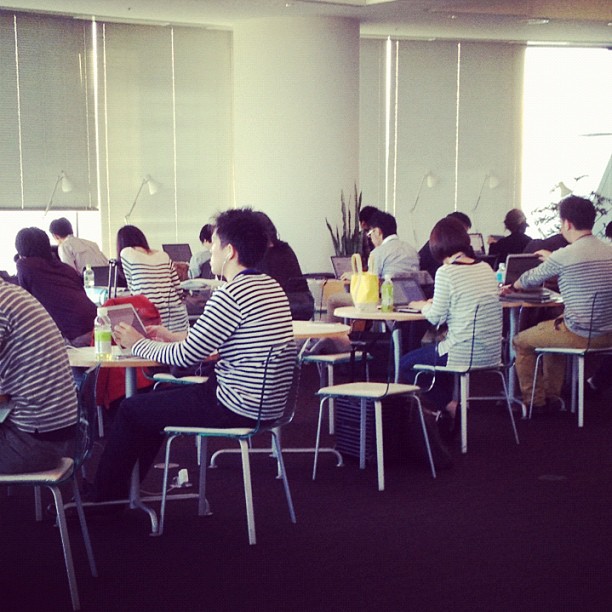
Japanese Calligraphy Rundown: A Quick Look
Japanese calligraphy (shodō) is the artistic form of writing the Japanese language. The master creates a work of art with bamboo brush and ink on rice paper; which transfers harmony and beauty. The parity of simplicity and grace is embodied in calligraphic works as one of the main principles in Japanese aesthetics (wabi sabi). There is nothing casual in Japanese calligraphy. The beginning, the direction, the form and the ending of lines, the balance between elements are important for each line and point, and even the empty space testifies about many things.The hieroglyphs are harmonious, proportional, balanced. For a long time, the most esteemed calligrapher in Japan had been Wang Xizhi, a Chinese calligrapher in the 4th century, but after the invention of Hiragana and Katakana, the Japanese unique syllabaries, the distinctive Japanese writing system developed and calligraphers produced styles intrinsic to Japan.
Photo by: V Calligraphy screen, side 1
Technique
During preparation, water is poured into the inkstone and the inkstick is ground against it, mixing the water with the dried ink to liquefy it. As this is a time-consuming process, modern-day calligraphy provides liquid ink in a bottle called Bokuju and is frequently used by beginners. More advanced students are encouraged to grind their own ink. The traditional and best position for calligraphy (as for ink painting) is on the ground. The brushes come in various shapes and sizes, and are usually made using animal hair for the bristles. Typical animal hair may come from goats, sheep, horse-hair, etc. The handle may be made from wood, bamboo, plastic or other materials.
Roots & Styles
Japanese calligraphy shares its roots with Chinese calligraphy and many of its principles and techniques are very similar and recognizes the same basic writing styles:
- seal script (篆書 tensho)
- clerical script (隸書 reisho)
- regular script (楷書 kaisho)
- semi-cursive (行書 gyōsho)
- cursive (草書 sōsho)
Tools
In modern calligraphy, a number of tools are utilized to make a composition. Traditionally these tools are:
- An inkstick (墨 sumi). The older the inkstick is, the better it is. The best inksticks are between 50 and 100 years old.
- Mulberry paper (和紙 washi)
- An inkstone (硯 suzuri) to grind the inkstick against, mixed with water.
- A paper weight (文鎮 bunchin) to hold the paper in place
- A cloth (下敷き shitajiki) to place under the paper to prevent ink from bleeding through.
- A brush (筆 fudé)
- A seal (The art of engraving a seal is called “tenkoku”. The student is encouraged to engrave his own seal. The position of the seal or the seals is based on aesthetic views. One is not allowed to put a seal on a sutra’s calligraphy.)
Tags: bunchin, Japanese calligraphy, shitajiki, sumi, suzuri, tenkoku, wabi-sabi, washi
Categorised in: Customs and Culture
This post was written by Mathew Ryan
Japanese Calligraphy Rundown: A Quick Look
Japanese calligraphy (shodō) is the artistic form of writing the Japanese language. The master creates a work of art with bamboo brush and ink on rice paper; which transfers harmony and beauty. The parity of simplicity and grace is embodied in calligraphic works as one of the main principles in Japanese aesthetics (wabi sabi). There is nothing casual in Japanese calligraphy. The beginning, the direction, the form and the ending of lines, the balance between elements are important for each line and point, and even the empty space testifies about many things.The hieroglyphs are harmonious, proportional, balanced. For a long time, the most esteemed calligrapher in Japan had been Wang Xizhi, a Chinese calligrapher in the 4th century, but after the invention of Hiragana and Katakana, the Japanese unique syllabaries, the distinctive Japanese writing system developed and calligraphers produced styles intrinsic to Japan.
Photo by: V Calligraphy screen, side 1
Technique
During preparation, water is poured into the inkstone and the inkstick is ground against it, mixing the water with the dried ink to liquefy it. As this is a time-consuming process, modern-day calligraphy provides liquid ink in a bottle called Bokuju and is frequently used by beginners. More advanced students are encouraged to grind their own ink. The traditional and best position for calligraphy (as for ink painting) is on the ground. The brushes come in various shapes and sizes, and are usually made using animal hair for the bristles. Typical animal hair may come from goats, sheep, horse-hair, etc. The handle may be made from wood, bamboo, plastic or other materials.
Roots & Styles
Japanese calligraphy shares its roots with Chinese calligraphy and many of its principles and techniques are very similar and recognizes the same basic writing styles:
- seal script (篆書 tensho)
- clerical script (隸書 reisho)
- regular script (楷書 kaisho)
- semi-cursive (行書 gyōsho)
- cursive (草書 sōsho)
Tools
In modern calligraphy, a number of tools are utilized to make a composition. Traditionally these tools are:
- An inkstick (墨 sumi). The older the inkstick is, the better it is. The best inksticks are between 50 and 100 years old.
- Mulberry paper (和紙 washi)
- An inkstone (硯 suzuri) to grind the inkstick against, mixed with water.
- A paper weight (文鎮 bunchin) to hold the paper in place
- A cloth (下敷き shitajiki) to place under the paper to prevent ink from bleeding through.
- A brush (筆 fudé)
- A seal (The art of engraving a seal is called “tenkoku”. The student is encouraged to engrave his own seal. The position of the seal or the seals is based on aesthetic views. One is not allowed to put a seal on a sutra’s calligraphy.)
Tags: bunchin, Japanese calligraphy, shitajiki, sumi, suzuri, tenkoku, wabi-sabi, washi
Categorised in: Customs and Culture
This post was written by Mathew Ryan